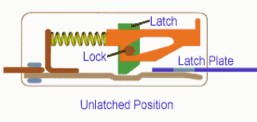Inertial Unlatching of Seat Belts
Your client swears he was wearing his belt or the witnesses you have lined up all state your client always wore a seat belt. But the police arrive at the scene and locate your client outside of the vehicle or in the back seat.
When you are faced with this situation, particularly when you have extremely serious injuries to your client, you may want to consider the very real possibility your client was wearing a seat belt and the force of the impact caused the buckle to unlatch.
This is a phenomenon described as an "inertial unlatching" of the buckle. Various studies have reported that inertially sensitive buckles are susceptible to "impact unlatching." One lawyer from South Carolina has amassed a collection of over 2,100 buckles and has conducted a study which has determined almost half could and would unlatch during an impact.

The best buckles are those which have a "lock-for-the-latch" whose patents date back to 1962. This drawing may help you understand the concept used in the more efficient buckles..
One engineer reported to NHTSA that as many as 30% of worn belts did not remain fastened in rollover accidents. A recent NHTSA report shows that the Ford Explorer RCF-67 Type 1 buckle will unlatch inertially (FE, VRTC-83-034, 1993). The NHTSA investigation continues on TRW seat belt buckle failures in ‘95 Explorers and is focusing on materials and manufacturing problems with the spring in the side release RCF Type1 design used in millions of GM and Ford models for more than 20 years.
Recent studies simulated an impact to a "Type 1" buckle with thin wall pipe similar to that employed on child seat. The "Type 1" buckle opened at speeds of 5 mph while the TRW Repa and Autoliv Lockarm buckle did not open up to 12.5 mph impact speeds. Sled studies with child seats have also demonstrated "Type 1" buckles unlatching.
The bottom line is this for practitioners: In a serious car crash do not overlook the very real possibility that the seat belt buckle unlatched and there may exist a cause of action for a defect in the crash-worthiness of the vehicle. The term "crash-worthiness", coined by NHTSA, means that the amount of protection a vehicle provides its passengers with against injury or death from a collision or accident.
 Chicago Car Accident Lawyers Bellas & Wachowski - Attorneys at Law Home
Chicago Car Accident Lawyers Bellas & Wachowski - Attorneys at Law Home












